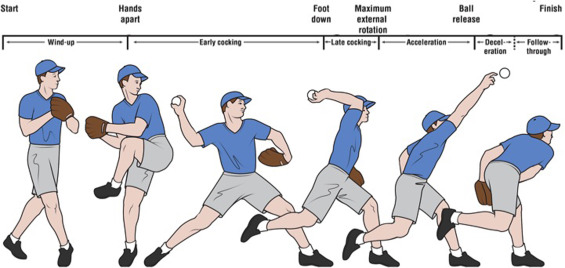Visits: 3
More than ever before, players, coaches, parents and others are searching for ways to prevent sports injuries. While a certain amount of injury is inevitable in any sport, modern science is finding new and innovative ways to reduce that amount. Proponents of proper biomechanics are on the forefront of these discoveries, and the entire sports world is beginning to take notice.
Especially in youth baseball, the increasing number of pitching injuries have forced athletes to look for innovative ways to treat and prevent these injuries. Tommy John surgery is being performed on pitchers before they even reach high-school, and specialization in sports is raising the pitch count for young athletes year-round. Now the science of biomechanics– which has been available to professional athletes for many years– is becoming more prevalent in amateur programs.
Breakthroughs in computer imaging and sports medicine have combined to provide a level of understanding in the area of pitching injuries that was impossible before. We can now accurately measure the movement of every muscle and bodily structure throughout the pitching motion. This provides insight into the mechanics behind a proper pitching motion, helping pitchers to improve their performance and reduce the likelihood of injury.
What is Biomechanics?
Biomechanics may sound like a complex, complicated scientific system, but it is actually designed to simplify the way we understand the motion of the human body. It is essentially the study of biological systems from a mechanical perspective. It is closely related to engineering, but it applies these principles to living organisms. While biomechanics can have many benefits to medicine, biology and many other fields, it has its most practical uses in the world of sports.
Sports biomechanics is a subfield that focuses specifically on the study and analysis of athletes and sports activity. Through mathematical modeling, computer simulation and quantitative measurement, scientists apply the laws of mechanics to the study of the human body in order to better understand their performance in sports. Sports biomechanics has also been called the “physics of sports,” and it allows us to better understand the motion of the human body.
Simply put, biomechanics studies the human body as if it were a machine. While a living organism is obviously more complex than any man-made mechanical device, biomechanics does provide some innovative insights into how the body moves.
The Biomechanics of Pitching
Pitching is a smooth, continuous motion that involves movement of the entire body over a very brief period. This makes it the perfect subject for biomechanical study, since it was previously impossible to make accurate measurements of each muscle throughout the process. Scientists are now able to use 3D imaging (similar to that used in sports video games), modern medical technologies and the laws of physics to understand pitching unlike ever before.
Over the last 30 years, several prominent scientists have published their research on the biomechanics of pitching and broken the motion down into a few separate actions. The first major study on pitching biomechanics (Jobe, Moynes, Tibone & Perry, 1984) divided pitching into three motions, but more recent research has used five or six phases. The most commonly used segments include:
- Wind Up: Posture is straight and leg is raised to work against gravity and store potential energy for upcoming motion.
- Stride: Abduction of the shoulder muscles raises the elbows to prepare for cocking. This is the beginning of the conversion of potential energy into mechanical energy.
- Cocking: This is the maximum external rotation of the shoulder, and the foot plant begins the “kinetic chain.”
- Acceleration: From the maximum lateral rotation of the shoulder to the moment the ball leaves the fingers. During this segment, the speed of the arm increases drastically in a time of approximately 50 milliseconds.
- Follow-through: From the point of release to the completion of motion when the leg moves forward and contacts the ground to stop the motion. This can be broken down into two separate phases of early follow-through (arm deceleration) and late follow-through (natural motion is restored).
Biomechanics and Pitching Injuries
While many early biomechanics studies were performed with the goal of improving pitching performance, many researchers are now focusing on reducing injuries and aiding rehabilitation. This was in large part due to the increased number of injuries and surgeries in young pitchers. Between 1988 and 1994, there were only seven instances of UCLR reconstruction (Tommy John) surgeries in pitchers under the age of 20. That number has dramatically increased in recent years, and 2011 alone saw 110 surgeries performed on pitchers ages of 10-19.
- Glenn Flesig, research director at the American Sports Medicine Institute (ASMI) and a pioneer in pitching biomechanics research, has helped to directly link high pitch counts to these injuries. In 2011, Flesig published a study in The American Journal of Sports Medicine, in which he studied amateur pitchers between ages 10-18. He found that those with pitch counts of more than 100 innings in a calendar year were 3.5 times more likely to suffer an injury.
Thanks to such research, Major League Baseball and USA Baseball launched the Pitch Smart program in 2014, which set standards of rest and lower pitch counts for young pitchers. In addition to providing new information and setting new standards, biomechanics has also been responsible for some of the new equipment that is designed to reduce pitching injuries. The elbow sleeve that many youth and professional pitchers now wear during warm-ups was designed by a company that specializes in biomechanics. Now companies design everything from uniforms to personalized blankets with some level of biomechanics in mind.
The most important thing that biomechanics provides to pitchers is information. Based on the research of specialists in sports biomechanics, pitchers now have more information than ever about how their bodies work during pitching. Proper understanding and implementation of this knowledge can lead to improved performance, reduced likelihood of injury and a longer career.




You must be logged in to post a comment Login